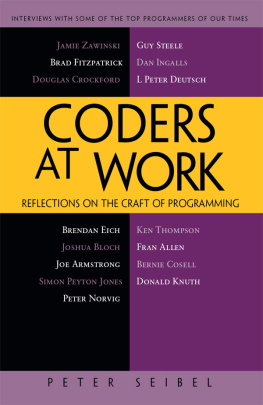Donald Knuth - The Art of Computer Programming
Here you can read online Donald Knuth - The Art of Computer Programming full text of the book (entire story) in english for free. Download pdf and epub, get meaning, cover and reviews about this ebook. year: 2019, publisher: Addison-Wesley Professional, genre: Computer / Science. Description of the work, (preface) as well as reviews are available. Best literature library LitArk.com created for fans of good reading and offers a wide selection of genres:
Romance novel
Science fiction
Adventure
Detective
Science
History
Home and family
Prose
Art
Politics
Computer
Non-fiction
Religion
Business
Children
Humor
Choose a favorite category and find really read worthwhile books. Enjoy immersion in the world of imagination, feel the emotions of the characters or learn something new for yourself, make an fascinating discovery.
- Book:The Art of Computer Programming
- Author:
- Publisher:Addison-Wesley Professional
- Genre:
- Year:2019
- Rating:5 / 5
- Favourites:Add to favourites
- Your mark:
The Art of Computer Programming: summary, description and annotation
We offer to read an annotation, description, summary or preface (depends on what the author of the book "The Art of Computer Programming" wrote himself). If you haven't found the necessary information about the book — write in the comments, we will try to find it.
This multivolume work on the analysis of algorithms has long been recognized as the definitive description of classical computer science. The four volumes published to date already comprise a unique and invaluable resource in programming theory and practice. Countless readers have spoken about the profound personal influence of Knuths writings. Scientists have marveled at the beauty and elegance of his analysis, while practicing programmers have successfully applied his cookbook solutions to their day-to-day problems. All have admired Knuth for the breadth, clarity, accuracy, and good humor found in his books.
To continue the fourth and later volumes of the set, and to update parts of the existing volumes, Knuth has created a series of small books called fascicles, which are published at regular intervals. Each fascicle encompasses a section or more of wholly new or revised material. Ultimately, the content of these fascicles will be rolled up into the comprehensive, final versions of each volume, and the enormous undertaking that began in 1962 will be complete.
This fascicle covers three separate topics:
- Mathematical Preliminaries. Knuth writes that this portion of fascicle 5 extends the Mathematical Preliminaries of Section 1.2 in Volume 1 to things that I didnt know about in the 1960s. Most of this new material deals with probabilities and expectations of random events; theres also an introduction to the theory of martingales.
- Backtracking: this section is the counterpart to section 7.2.1 which covered the generation of basic combinatorial patterns. This section covers non-basic patterns, ones where the developer needs to make tentative choices and then may need to backtrack when those choices need revision.
- Dancing Links: this section is related to 2 above. It develops an important data structure technique that is suitable for backtrack programming described above.
Donald Knuth: author's other books
Who wrote The Art of Computer Programming? Find out the surname, the name of the author of the book and a list of all author's works by series.











